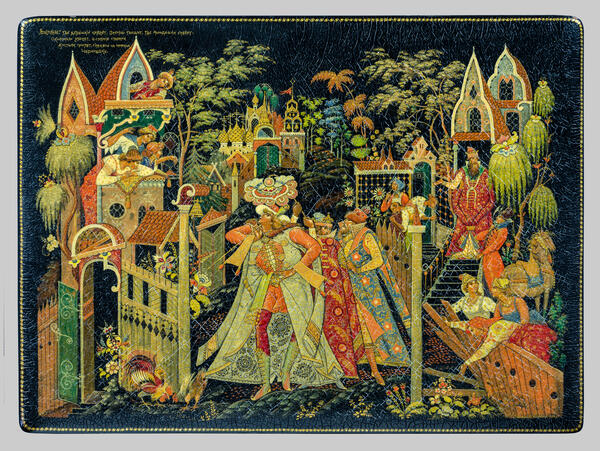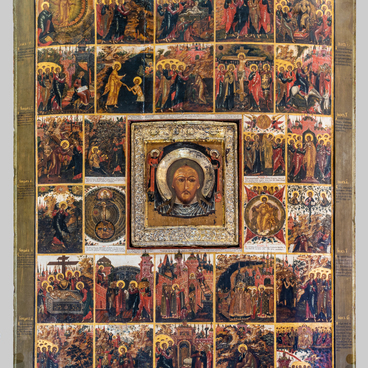Pavel Bazhenov became the first student of the Palekh miniaturists who founded the Artel of Ancient Painting. He was accepted into the group in 1926. At first, he copied the works of his teachers Ivan Golikov, Ivan Bakanov, and Dmitry Butorin, so his early works were imitative. But it was thanks to copying that he took the best from the traditional Palekh painting school and became its worthy successor.
In the miniature ‘Churilo Plenkovich, ’ made in 1934, the artist already demonstrates his creative maturity. He became a pioneer and was the first of the Palekh artists to turn to the subject of Russian epics. Churilo Plenkovich, the main character of an eponymous epic, was a robber who operated in the vicinity of Kyiv and plundered peasant houses. But he became famous not because of his acts, but because of his lush outfits and entertaining marches along the streets of ancient Kiev.
The artist accurately followed the text of the epic. He introduced it into the miniature and painted the scene in accordance with it: ‘The girls are looking, the fences are creaking, the young ones are staring, the windows are ringing, and the old women gnaw at their crutches when they look at Churilushka…’ The author consistently depicted how people poured out onto the streets and broke fences to marvel at the unusual appearance of the fancy-dressed young men. Especially noteworthy are the old women gnawing at their crutches.
Churila’s image is widely associated with a rooster spreading its tail in front of a chicken. This comparison became the leitmotif of the composition. The artist depicted a rooster in front and a little to the left of the pretentious Churila.
Pavel Bazhenov flawlessly applied the rhythmic pattern to the surface of the casket. He had excellent drawing skills, so he preferred the style of graphic art (when an artist is said to have “excellent drawing skills”, it means that they have masterful lines and strokes. If the picture had been black and white or made with a simple pencil on paper, without color, it would have still retained the beauty of the costume ornaments, the elegance of turrets and ladders, and the expressiveness of faces). Pavel Bazhenov skillfully outlined the curves of figures and the delicate architectural details. He also proved himself a pioneer in the execution of faces, hands, and legs: Bazhenov conveyed their volume by using light and shadow modeling and highlighting the details with graphics. The painting’s ornaments were clearly influenced by oriental miniatures.
But the artist’s work with color also should not be ignored. He created an amazing light silver color scheme with many bright red details. Red, with its many shades, was Pavel Bazhenov’s favorite color. In this miniature, he managed to balance the colors so that they would look festive but not flashy. The color range corresponds to the lighthearted, humorous style of the epic.
Sadly, Pavel Bazhenov passed away at a young age. He was born in 1904 and died in 1941 during the first year of the Great Patriotic War, when his talent had already manifested in full force.
In the miniature ‘Churilo Plenkovich, ’ made in 1934, the artist already demonstrates his creative maturity. He became a pioneer and was the first of the Palekh artists to turn to the subject of Russian epics. Churilo Plenkovich, the main character of an eponymous epic, was a robber who operated in the vicinity of Kyiv and plundered peasant houses. But he became famous not because of his acts, but because of his lush outfits and entertaining marches along the streets of ancient Kiev.
The artist accurately followed the text of the epic. He introduced it into the miniature and painted the scene in accordance with it: ‘The girls are looking, the fences are creaking, the young ones are staring, the windows are ringing, and the old women gnaw at their crutches when they look at Churilushka…’ The author consistently depicted how people poured out onto the streets and broke fences to marvel at the unusual appearance of the fancy-dressed young men. Especially noteworthy are the old women gnawing at their crutches.
Churila’s image is widely associated with a rooster spreading its tail in front of a chicken. This comparison became the leitmotif of the composition. The artist depicted a rooster in front and a little to the left of the pretentious Churila.
Pavel Bazhenov flawlessly applied the rhythmic pattern to the surface of the casket. He had excellent drawing skills, so he preferred the style of graphic art (when an artist is said to have “excellent drawing skills”, it means that they have masterful lines and strokes. If the picture had been black and white or made with a simple pencil on paper, without color, it would have still retained the beauty of the costume ornaments, the elegance of turrets and ladders, and the expressiveness of faces). Pavel Bazhenov skillfully outlined the curves of figures and the delicate architectural details. He also proved himself a pioneer in the execution of faces, hands, and legs: Bazhenov conveyed their volume by using light and shadow modeling and highlighting the details with graphics. The painting’s ornaments were clearly influenced by oriental miniatures.
But the artist’s work with color also should not be ignored. He created an amazing light silver color scheme with many bright red details. Red, with its many shades, was Pavel Bazhenov’s favorite color. In this miniature, he managed to balance the colors so that they would look festive but not flashy. The color range corresponds to the lighthearted, humorous style of the epic.
Sadly, Pavel Bazhenov passed away at a young age. He was born in 1904 and died in 1941 during the first year of the Great Patriotic War, when his talent had already manifested in full force.



